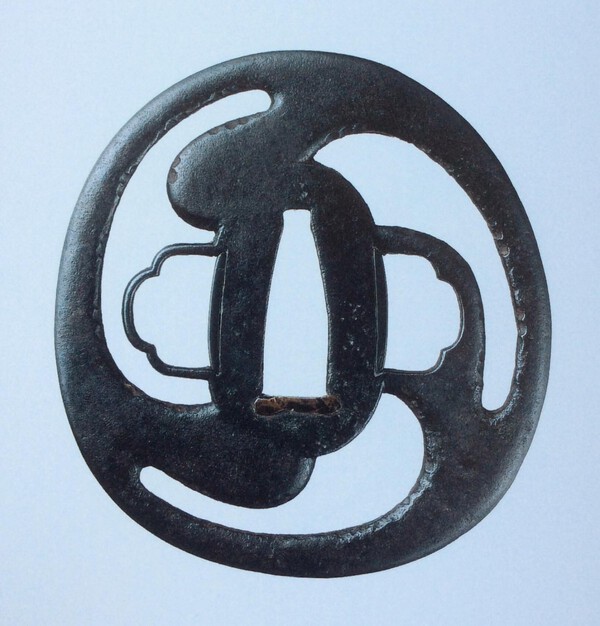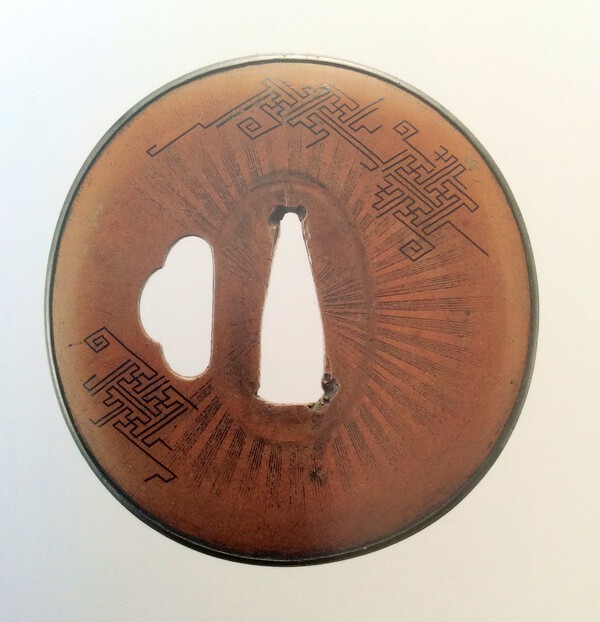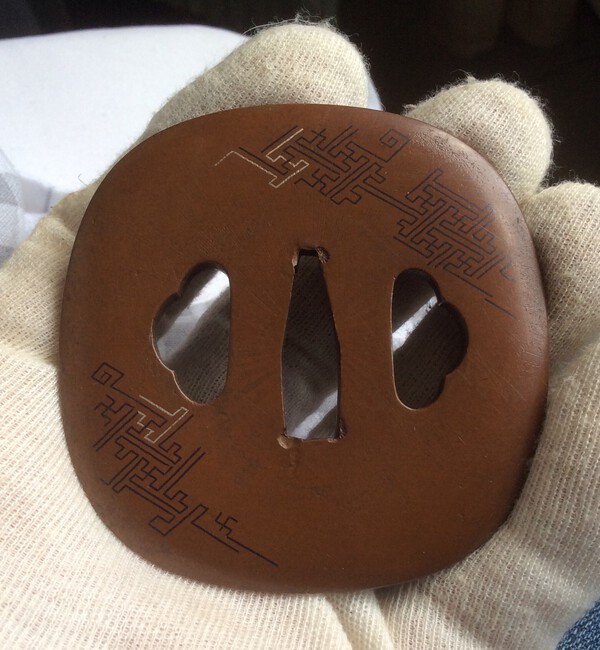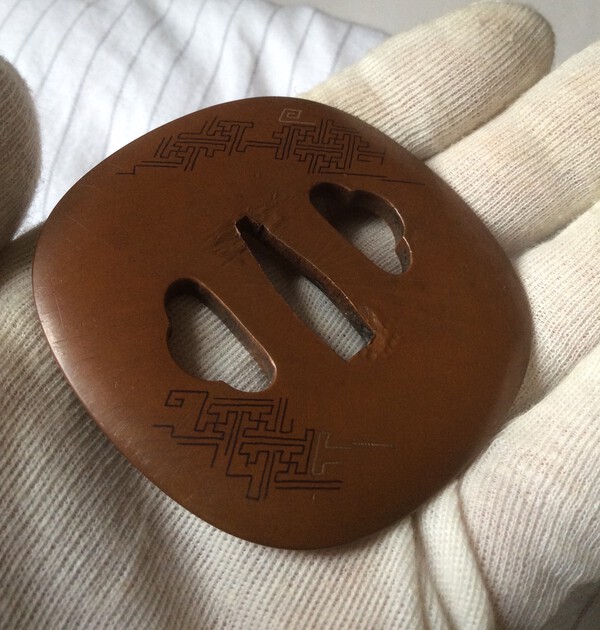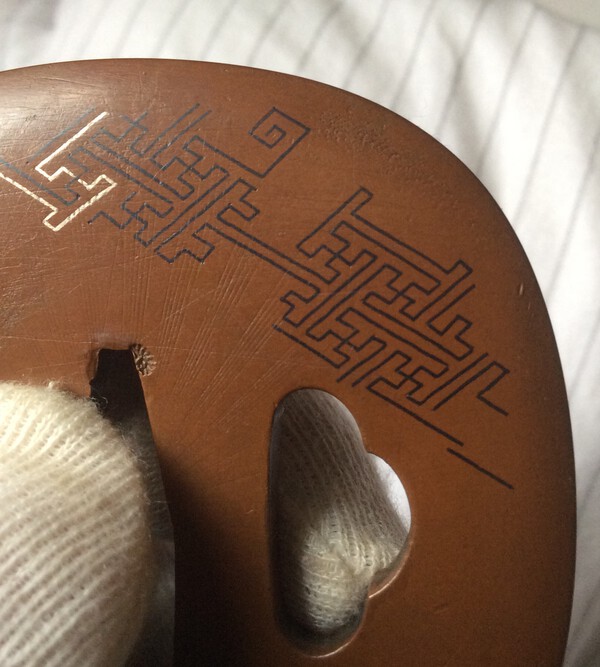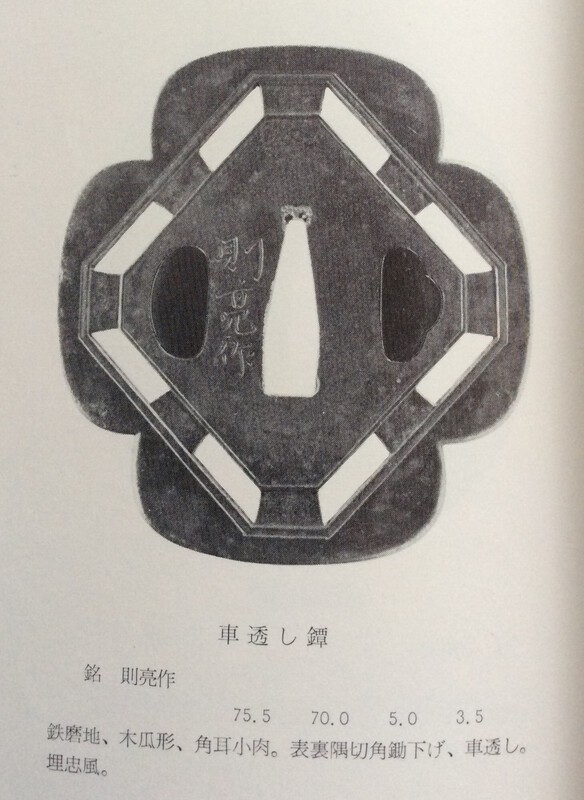-
Posts
245 -
Joined
-
Last visited
-
Days Won
1
Everything posted by Michael 101
-
I tend to agree with the Sado island call for this one. They are usually very beefy examples with beautiful iron quality. Quite often mistaken for Akasaka due to the thickness. Looks a very nice example. Kindest regards Michael
-
Interesting tsuba - design common across the Higo schools with examples seen by the first Shimizu Jingo master, nishigaki kanshiro etc. The flat round shape ( aori ) is what instantly marks this example out as Higo - apart from the signature ! Kampei did some very good work and we sometimes see fake signature examples on the market. However, this looks good to my eyes and has his name and age on the reverse which is typical of him. It is also signed with his age (70 years). I have another example with the same age and the signature appears exactly the same. I would be interested to know the size of this tsuba - his are rarely large ( 7.5cm would be typical ) but usually pleasingly thick 0.5cm so they tend to be quite heavy. Looking forward to seeing better pictures whe it arrives - a very good purchase. Kind regards Michael
-
Hi Antii, Good too see some high quality Higo tsuba listed - Daniel's looks like it could be a daisho pair with yours and both look distinctly similar to my eye. The elongated round shape to both is very attractive and typical for earlier Nishigaki Kanshiro work. Interesting to note the shaping around the nakago ana of both tsuba - a feature found in a number of published 2nd master examples. Its very difficult to capture the beautiful and correct colour of iron tsuba - your second picture I think would be closer to reality. Thanks for showing Kindest regards Michael
-
Thanks Dirk, yes that is also a nice one it is also published in the Higo Kinko Taikan. Thank you Ludolf - another fine example - I hadnt seen that one and greatly appreciate you adding to this thread. Has anyone seen a Shodai version of this design as so far it seems a favourite of the 3rd master. Kindest regards Michael
-
Dear members, Does anyone have a copy of the above book that they could help me with ? I have the Haynes translation and I would like to see the original photogragh of the Jingo Crysanthemum tsuba illustrated on page 154 ( in the translation copy ) see attached picture. If someone could send a scan of the illustration and page from the original book I would be very greatful. Kindest regards Michael
-
Hi David, He was known to copy earlier Hayashi designs (but did also develop his own) - so it would be highly likely that he would have copied Nishigaki too. Tsuba are rarely seen by him - so its hard to confirm for certain. Kindest regards Michael
-
Hello James - please add me to the list. Kindest regards Michael
-
Sorry I couldnt work out how to add the picture of the 3rd master Nishigaki but I will message it to you ( you can add it to the topic if you can work it out ) Kindest regards Michael
-
Hi Pete, A very nice tsuba and also quite rare tsuba. Im my opinion ( from your pictures ) is that it was most likely made by Tani Seibei. Unfortunately not much is known about this Higo worker although other than he is believed to have died in 1843 in his 70's As mentioned by others the design of your tsuba is very much in the style of the Nishigaki school - in particular the third master ( 1680-1761) See picture attached as a comparison to your own. Tani was well known for his aplicaption of Kuyo mon in the style of your work and this is the main reason I think he was the maker of your tsuba ( and subtle differences in the actual tsuba - not quite as free flowing as the earlier Nishigaki masters ) Tsuba by Tani are rare, he is more well known for his fuchikashira. Kindest regards Michael
-
Thank you for posting the link to a very similar tsuba but this time attributed to Yogoro school, as I note are two other very different tsuba from the same sale. Its very interesting as other Yogoro (Mito) work also points towards a conection with the Goto school (to whom the second Kanshiro studied under) and thank you for posting. To clarify my kantei was based purely on my own studies and discussion with another more experienced higo collector and close reference to Ito Mitsuhira's excellent publications and studies. Attributions change as more information becomes available and I very much respect the focused higo school research carried out by Mitsuhira san in his recent work. This tsuba does not have any papers - I would submit - my only concern would be the return of another rather expensive "Higo" attribution. Kindest regards and thanks Michael
-
I can fully understand the various calls, especially so for Umetada. Not an easy one at all, which is the fun of these anyway. Only one person nailed it - Higo Nishigaki more specifically the second master Shigesaku (1639-1717) The very tastefully placed inlaid pattern is called Sayagata, a crest design originally found on silk. This example shows some wear and would most likely have been originally fitted with a shakudo fukurin. The second master also studied under the Goto school and his work is often very refined. Unfortunately my photos do not do it justice as the amida yasuri are very finely carved. The aori gata shape and the matching hitsu ana are more typically Higo in style. I have added a picture of a very similar example complete with its fukurin, published in Ito Mitsuhira's excellent book on Nishigaki Kanshiro works for comparison. Many thanks Michael
-
Thought yesterdays kantei was good fun and thought Id add one of my own. This one is distinctly go stone in profile (thicker in the middle) and in addition to its shakudo and silver inlay has finely carved amida yasuri. Its 7cm high x 6.9cm wide x 0.48cm thick at the centre. Let me know your thoughts or questions Kind regards Michael
-
Shoami very similar to Akasaka but still sticking with Shoami. Kindest regards Michael
-
Hello Gethin, An Interesting tsuba not an easy one to place - although I am reasonably sure its not Hirata. Satsuma is a possibility but I would also look into Sado Island work as another potential source. I cant easily explain why, it just reminds me of a papered Sado work I once owned. Good quality iron and a very nice tsuba. Kindest regards Michael
-
Hi Peter, Could well be Akasaka - could you help by providing the measurements, height, width and thickness (at thinest and thickest parts) Kindest regards Michael
-
Hi gentleman, I have owned at least 6 hirado tsuba over the years (including one of the ones pictured above) some signed others not - they vary from the massive brass "door knocker" type to some very delicately carved signed examples. Also signed fuchi kashira and kozuka. There is a huge variation in this schools work and possibly three generations. Plus their work was much copied - for example the one kindly shown by David is very similar to ones also made by Norisuke. I suggest the tsuba was possibly made in the hirado style either by one of the kunishige generations or a school worker or even a copyist inspired by their style. Not sure we can get any closer. Just wanted to add that I do not confess to having any great knowledge on this school - just floating an idea that others can shoot down or expand on. Kindest regards Michael
-
My guess for the maker would be Hirado Kunishige who was from Hizen late 18th early 19th century. He favoured this type of cloud / wave combination. You can look him up easily on the web for more detail. Kindest regards Michael
-
Hi Bruno, I can confirm that the mon is not restricted to the shoami school - I can recall Ko Akasaka (mon with the axe) and Owari as well as Nobuiye examples. Kindest regards Michael
-
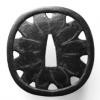
Translation of a box seal / chop mark
Michael 101 replied to Michael 101's topic in Translation Assistance
Thanks another member translated as "Red Mountain" Anyone seen this one before ? Kindest regards Michael -
Can anyone help ? Recently bought a very nice tsuba. The box had no hakogaki or markings other than this very clean chop Mark. Does anyone recognize it or able to translate the name? Please see attached picture Kindest regards Michael
-
Probably Benten goddess of luck, love the arts etc She is often seen playing music seated on a dragon Kindest regards Michael
-
Hi David, I have to agree with the last comment - I would look to another school - perhaps Myochin rather than Higo for this tsuba. The hitsu style is very Higo in style but the mimi is not. I think you have its age spot on - at that late period many schools designs merged and Myochin and others such as Norisuke were masters at copying the latest fashions. However its a really nice tsuba so well done on adding it to your collection. Kindest regards Michael
-
Hi David, Im certain that they would have. Ito quotes some of the leading Tsuboi makers as Yoshida Noriharu, Sakamoto Yaichi, Sakanashi Gorobei, Miyazaki Kanzo, Miyanaga Nenokichi and Tanabe Yasuhira. Makers such as Noriharu specialised in Jingo utsushi. Hope this helps. Kindest regards Michael
-
In Higo metal working terms its referred to as Koboku (ko or kareru - dead ) ( boku, moku, ki - Tree) as explained by one of the leading modern scholars on this subject Ito Mitsuru. Tsuboi is a district rather than school or family, its where numerous metal workers lived, many of which specialised in producing affordable copies of famous makers for less well off samurai. It was also the home district to several masters such as 3rd Kamiyoshi master. Think of it in a similar way to Hong Kong providing copies of Rolex watches for the masses. Main Higo school works by the masters would have been largely restricted to the Hosakawa and senior retainers and way above the pocket of the average samurai - who wishing to stay in fashion would purchase a more economical copy. Some workers were incredibly skilled and it is believed that many of their works get papered to main school. Kindest regards Michael




